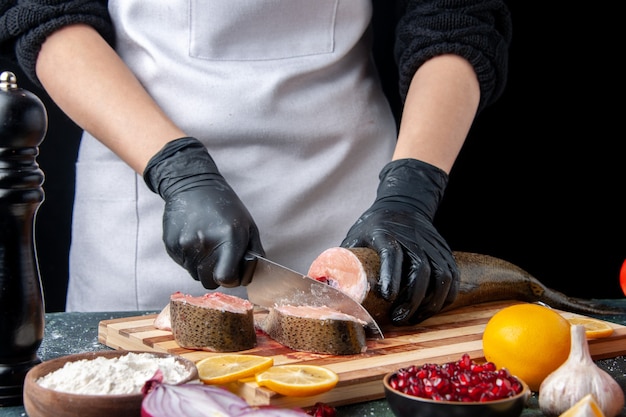Let's talk swordfish, folks. This firm, white fish with a hint of sweetness has a special place in my heart, but getting it just right can be a bit of a culinary puzzle. Undercook it, and you're left with a rubbery mouthful. Overcook it, and it's drier than the Sahara. Been there, done that, got the T-shirt, and let me tell you, it's not a good look. So, I'm on a mission to demystify swordfish cooking and share my hard-earned wisdom with you. Let's ditch the rubbery or dry disasters and welcome juicy, delicious swordfish cooked to perfection!
(Part 1) Understanding Swordfish: The Basics

Swordfish Anatomy: A Closer Look
First, let's get acquainted with this fascinating fish. Swordfish, with their impressive, sword-like bill, are known for their long journeys across the globe, navigating both tropical and temperate waters. When you're shopping for swordfish, you'll typically find it in steaks, which are cross-sections taken from the thicker, meatier part of the fish. This is where the culinary magic happens, as the steaks are generally the most tender and flavorful.
The Unique Texture and Flavour of Swordfish
Swordfish is a unique fish, offering a firm, white flesh with a subtle sweetness. It's often described as having a slightly "meaty" texture, a welcome contrast to the flakiness of cod or haddock. This makes it a great choice for grilling or pan-frying, as it holds its shape beautifully during cooking, adding to its appeal.
(Part 2) Doneness Guide: Finding Your Perfect Match

Doneness Matters: A Matter of Personal Preference
When it comes to cooking swordfish, there's no one-size-fits-all approach. Everyone has their preferred level of doneness, and that's perfectly fine. Some prefer a well-cooked, opaque center, while others revel in the tenderness of a slightly pink interior. It's all about finding your personal sweet spot.
Signs of Doneness: Reading the Clues
So, how do you know if your swordfish is cooked to your liking? Here are a few telltale signs:
- Colour Change: As the swordfish cooks, the flesh will transition from a translucent pink to a more opaque white or off-white hue. This is a visual cue that the protein is transforming.
- Firming Up: The fish will become firmer as it cooks, indicating that the proteins are tightening and holding their shape.
- Flaking Test: A gentle press on the surface of the cooked swordfish should reveal easy flaking, a sign that it's ready to enjoy.
Doneness Chart: Your Cooking Companion
Here's a handy chart to guide your swordfish cooking adventures:
| Doneness | internal temperature (°F) | Cooking Time (Minutes per inch thickness) | Appearance |
|---|---|---|---|
| Rare | 125-130 | 4-5 | Slightly pink center, firm texture |
| Medium-Rare | 130-140 | 5-6 | Pale pink center, firm texture |
| Medium | 140-145 | 6-7 | Slightly white center, firmer texture |
| Medium-Well | 145-150 | 7-8 | White center, firm texture |
| Well-Done | 150 | 8-10 | Completely white center, very firm texture |
Remember, these are just guidelines. The actual cooking time can fluctuate based on the thickness of your swordfish, the intensity of your pan or grill heat, and even your oven's quirks. Always rely on a meat thermometer to be sure your swordfish is cooked to your satisfaction.
(Part 3) Cooking Methods: Master Your Craft

Now, let's dive into the different ways to cook swordfish. Each method offers its own unique flavour and texture, so explore and find your favorites.
1. Pan-Frying: Crisp Crust, Juicy Inside
Pan-frying is a fantastic method for creating a beautiful, crispy crust while preserving the juicy tenderness inside. Here's my go-to approach:
- Pat Dry: Start by patting your swordfish steaks dry with paper towels. This helps create a crisp crust by preventing steam buildup during cooking.
- Season Generously: Don't be shy with the salt, pepper, herbs, and spices! I often use a simple combination of salt, pepper, and a squeeze of lemon juice. You can experiment with your favorite herbs and spices.
- Hot Pan, Heavy Bottom: Use a good quality pan with a heavy bottom, preferably cast iron. Heat your pan over medium-high heat until it's hot, but not smoking.
- Oil is Key: Add a thin layer of oil to the hot pan, just enough to coat the bottom.
- Cook in Batches: Don't overcrowd the pan. Cook your swordfish steaks in batches if necessary to ensure even cooking.
- 2-3 Minutes per Side: Cook for 2-3 minutes per side, or until the fish is opaque and flakes easily.
- Check for Doneness: Use a meat thermometer or the flaking test to determine if your swordfish is cooked to your liking.
2. Grilling: Smoky Goodness
For that smoky, charred flavour, grilling is a winner. Remember, a hot grill is crucial for perfectly grilled swordfish.
- Preheat to Perfection: Make sure your grill is preheated to medium-high heat. A hot grill sears the exterior quickly, creating those beautiful grill marks.
- Pat Dry, Season Well: Pat your swordfish steaks dry and season generously with salt, pepper, and any herbs or spices you love.
- 4-6 Minutes per Side: Grill for 4-6 minutes per side, depending on your desired doneness.
- Doneness Check: Use a meat thermometer or the flaking test to make sure your swordfish is cooked to your liking.
3. Baking: Simple and Fuss-Free
If you prefer a straightforward and fuss-free cooking method, baking is a great option. It's ideal for larger pieces of swordfish, and it results in a slightly moister fish.
- Oven Pre-Heat: Set your oven to 400°F (200°C).
- Dry and Season: Pat your swordfish steaks dry and season them generously with salt, pepper, and any desired herbs and spices.
- Parchment Paper: Line a baking sheet with parchment paper for easy cleanup.
- Bake Away: Place your swordfish steaks on the prepared baking sheet and bake for 15-20 minutes, or until cooked through.
- Doneness Check: Use a meat thermometer or the flaking test to ensure your swordfish is cooked to perfection.
4. Broiling: Fast and Charred
Broiling is a quick and easy way to cook swordfish, offering a beautiful charred top. Here's how to do it:
- Broiler Preheat: Preheat your broiler to high heat.
- Dry and Season: Pat your swordfish steaks dry and season them generously with salt, pepper, and your favorite herbs and spices.
- Parchment Paper: Line a baking sheet with parchment paper to prevent sticking.
- Broil Carefully: Place your swordfish steaks on the prepared baking sheet and broil for 5-7 minutes, watching carefully to avoid burning.
- Doneness Check: Use a meat thermometer or the flaking test to ensure your swordfish is cooked to your liking.
(Part 4) Delicious swordfish recipes: Get Inspired
Now, for the fun part: some scrumptious swordfish recipes to get your taste buds tingling. These are my tried and true favorites, so you can trust me on this.
1. Grilled Swordfish with Lemon-Herb Butter: A Classic
This recipe is a classic for a reason. The juicy swordfish, boasting those smoky grill marks, is beautifully complemented by the zesty, aromatic lemon-herb butter. It's simple yet divine. Here's what you'll need:
- 1 pound swordfish steaks
- 2 tablespoons butter
- 1 tablespoon lemon juice
- 1 tablespoon chopped fresh parsley
- 1 tablespoon chopped fresh dill
- Salt and pepper to taste
Instructions:
- Preheat your grill to medium-high heat.
- Pat your swordfish steaks dry and season them generously with salt and pepper.
- In a small bowl, combine the butter, lemon juice, parsley, and dill. Mix well.
- Grill your swordfish steaks for 4-6 minutes per side, or until cooked to your preference.
- Top each steak with a generous dollop of the lemon-herb butter and serve immediately.
2. Pan-Seared Swordfish with Roasted Vegetables: A Colourful Feast
This recipe is a testament to how swordfish can be the star of a simple yet satisfying meal. The pan-seared swordfish, with its lovely crust, is perfectly paired with the vibrant and flavourful roasted vegetables. Here's what you'll need:
- 1 pound swordfish steaks
- 1 tablespoon olive oil
- Salt and pepper to taste
- 1 cup broccoli florets
- 1 cup cherry tomatoes
- 1/2 cup red onion, sliced
- 2 tablespoons balsamic vinegar
- 1 tablespoon chopped fresh thyme
Instructions:
- Preheat your oven to 400°F (200°C).
- Pat your swordfish steaks dry and season them generously with salt and pepper.
- In a large bowl, toss the broccoli, cherry tomatoes, and red onion with olive oil, balsamic vinegar, and thyme. Season with salt and pepper.
- Spread the vegetables on a baking sheet and roast for 15-20 minutes, or until tender.
- While the vegetables are roasting, heat a pan over medium-high heat and add a little olive oil.
- Pan-sear your swordfish steaks for 2-3 minutes per side, or until cooked to your liking.
- Serve your swordfish steaks over the roasted vegetables and enjoy!
3. baked swordfish with Garlic and Herbs: Weeknight Wonder
This recipe is a winner for busy weeknights. It's simple, flavorful, and incredibly easy to prepare. Here's what you'll need:
- 1 pound swordfish steaks
- 2 tablespoons olive oil
- 2 cloves garlic, minced
- 1 tablespoon chopped fresh oregano
- 1 tablespoon chopped fresh parsley
- Salt and pepper to taste
Instructions:
- Preheat your oven to 400°F (200°C).
- Pat your swordfish steaks dry and season them generously with salt and pepper.
- In a small bowl, combine the olive oil, minced garlic, oregano, and parsley. Mix well.
- Spread the herb mixture evenly over your swordfish steaks.
- Place the swordfish steaks on a baking sheet and bake for 15-20 minutes, or until cooked through.
- Serve immediately and enjoy!
(Part 5) Tips for Cooking Swordfish: Elevate Your Skills
Let's talk about some essential tips to take your swordfish cooking to the next level.
1. Don't Overcook It: Tenderness is Key
Swordfish, like many delicate fish, can easily become dry and rubbery if overcooked. Aim for a slightly pink center for optimal tenderness and flavor. Remember, you can always cook it a little longer if you're unsure, but you can't undo overcooking.
2. Season Generously: Flavor Fusion
Swordfish's subtle sweetness makes it a perfect canvas for a variety of seasonings. Don't be afraid to use salt, pepper, herbs, and spices generously. I love using fresh herbs like dill, parsley, oregano, and thyme, but you can also experiment with paprika, cumin, or chili powder. The key is to create a balanced flavor profile without overpowering the delicate taste of the swordfish.
3. Meat Thermometer: Your Reliable Guide
Using a meat thermometer is the best way to ensure your swordfish is cooked to your liking. Insert the thermometer into the thickest part of the fish, avoiding the bone. The internal temperature should reach 140-145°F for medium-cooked swordfish.
4. Rest Before Serving: Let the Juices Redistribute
Let your cooked swordfish rest for a few minutes before serving. This allows the juices to redistribute throughout the fish, resulting in a more tender and flavorful steak.
(Part 6) FAQs about Swordfish: Clearing Up Common Queries
Here are answers to some commonly asked questions about swordfish.
1. Is Swordfish Safe to Eat?
Yes, swordfish is generally safe to eat. However, there are concerns about mercury levels in swordfish. Mercury is a heavy metal that can accumulate in fish, especially larger predatory fish like swordfish. High levels of mercury can be harmful, particularly for pregnant women, young children, and nursing mothers. The FDA recommends limiting consumption of swordfish to no more than one serving per week.
2. What Does Swordfish Taste Like?
Swordfish has a firm texture and a slightly sweet, delicate flavor. It's often described as having a "meaty" texture, making it a satisfying and flavorful fish.
3. How Do You Tell if Swordfish is Fresh?
Here are some key signs of fresh swordfish:
- Colour: The flesh should be a bright, translucent pink.
- Smell: It should have a fresh, clean ocean scent.
- Texture: The flesh should be firm and springy to the touch.
- Eyes: The eyes should be clear and bright.
- Gills: The gills should be a bright red colour.
If the swordfish has a strong fishy smell, is slimy, or has dull eyes, it's best to steer clear.
4. Can You Freeze Swordfish?
Yes, you can freeze swordfish. It's best to freeze it in airtight containers or freezer-safe bags. Swordfish can be frozen for up to 3 months. Thaw it in the refrigerator overnight when you're ready to use it.
5. Can You Eat Swordfish Raw?
It's not recommended to eat swordfish raw. Like all fish, swordfish can contain parasites that can make you sick. Always cook swordfish thoroughly to kill any potential parasites.
(Part 7) Final Thoughts: Embrace the Adventure
There you have it, my comprehensive guide to cooking swordfish. I hope you found it helpful and informative. Remember, cooking swordfish is all about finding the right balance between doneness and flavor. Don't be afraid to experiment with different cooking methods, seasonings, and recipes. Most importantly, enjoy the journey! After all, cooking should be fun.
Everyone is watching

How to Cook Frozen Lobster Tails Perfectly: A Step-by-Step Guide
RecipesLobster. Just the word conjures up images of lavish meals, special occasions, and a taste of luxury. But let's...

Pigs in a Blanket Cooking Time: How Long to Bake for Perfect Results
RecipesAh, pigs in a blanket. Just the name conjures up images of those delightful little parcels of crispy pastry en...

Pork Fillet Cooking Time: How Long to Cook It Perfectly
RecipesPork fillet, or tenderloin as it's sometimes called, is a real favourite in our house. It's so versatile, and...

The Ultimate Guide to Tender, Juicy Pulled Pork
RecipesRight, let's talk pulled pork. It's one of those dishes that just screams "comfort food," doesn't it? I mean...

The Ultimate Guide to Cooking Sweet Potatoes: From Roasting to Mashing
RecipesSweet potatoes. Just the name conjures up images of warm, comforting dishes, bursts of vibrant color, and a to...
